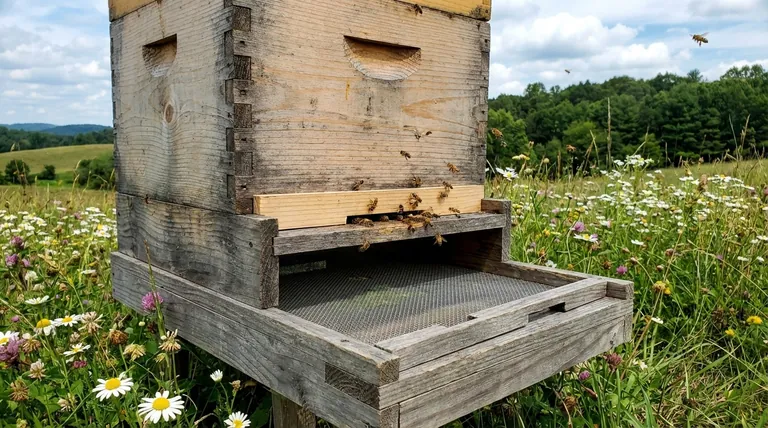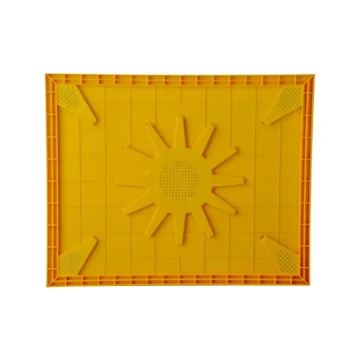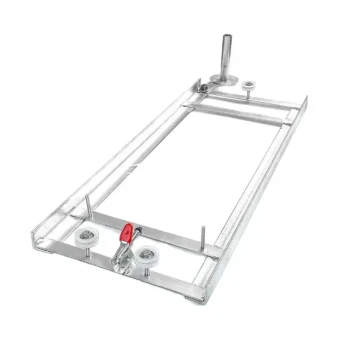Deciding how to manage your screened bottom board is a fundamental question for modern beekeepers. The consensus among experienced apiarists is to leave the screen open year-round, even in colder climates. This approach prioritizes ventilation and pest management, which are critical for colony health, over the outdated notion of sealing a hive for warmth.
The core purpose of a screened bottom board is not to cool the hive, but to control moisture and pests. Keeping it open provides essential ventilation that prevents deadly moisture buildup in winter, a far greater threat to a colony than the cold itself.

The Core Functions of a Screened Bottom Board
Understanding why a screened bottom board works is key to using it effectively. It serves two primary functions that directly impact the health and survival of your bees.
Superior Ventilation and Moisture Control
Honeybees generate a significant amount of water vapor through respiration. In a sealed hive, especially during winter, this warm, moist air rises, hits the cold inner cover, and condenses into water droplets.
This condensation then drips down onto the cluster, chilling the bees. A wet bee is often a dead bee. A screened bottom board allows this heavy, moist air to exit the hive, creating a "chimney effect" that keeps the colony dry.
Integrated Pest Management (Varroa Mites)
The Varroa destructor mite is the single greatest threat to honeybee colonies. When mites lose their grip or are groomed off by bees, they fall to the bottom of the hive.
With a solid bottom board, these mites can simply climb back onto a passing bee. A screened bottom ensures that a significant portion of fallen mites drop completely out of the hive, breaking their life cycle and reducing the overall pest load on the colony. You can also slide a corrugated plastic "sticky board" underneath the screen for 24-72 hours to accurately monitor mite levels.
Reducing Summer Heat Stress
In hot weather, a colony must expend considerable energy fanning their wings to ventilate the hive and cool the brood nest. An open screen provides natural, passive airflow.
This ventilation helps reduce the internal temperature, freeing up forager bees from "fanning duty" so they can focus on collecting nectar and pollen.
Debunking the "Winter Cold" Myth
The most common concern about leaving a screen open is that the colony will freeze in winter. This fear is based on a misunderstanding of how bees survive the cold.
Bees Heat the Cluster, Not the Hive
Honeybees do not heat the entire hive cavity like a central furnace heats a house. Instead, they form a tight cluster and vibrate their wing muscles to generate heat, keeping the center of the cluster at a stable, warm temperature.
The outer layer of bees in the cluster acts as a dense, insulating mantle. The colony is perfectly capable of regulating its own temperature as long as it has sufficient honey stores for energy.
Why Moisture is More Dangerous Than Cold
A dry colony can withstand surprisingly low temperatures. The real winter killer is moisture combined with cold.
A screened bottom board, by ensuring a dry interior, is one of the most effective tools for winter survival. It is far better for a colony to be cold and dry than to be damp and slightly warmer.
Understanding the Trade-offs and Exceptions
While "open year-round" is the standard advice, there are specific situations where a modification might be considered. These are exceptions, not the rule.
Exception: Extreme Wind and Cold
In regions with exceptionally harsh winters, such as northern Canada or Alaska, beekeepers sometimes slide the insert in partially to act as a windbreak. This is done to prevent severe drafts from blowing directly up into the winter cluster.
However, even in these cases, the board is rarely, if ever, closed completely. Leaving a small gap is still crucial for moisture to escape.
Exception: Establishing New or Weak Colonies
A newly installed package of bees or a small nucleus colony has a much smaller population. They have less manpower to generate heat and regulate their temperature.
For these small colonies, especially during a cool spring, temporarily closing the bottom board for a few weeks can help them conserve energy and focus on building their population and drawing out comb. Once the colony is established and growing, the board should be opened.
Making the Right Decision for Your Apiary
Your strategy should be based on your specific climate and the strength of your individual colonies.
- If your primary focus is hive health in a temperate or hot climate: Leave the screened bottom board fully open year-round for maximum ventilation and mite reduction.
- If your primary focus is overwintering in a cold climate: Leave the screen open to ensure the colony stays dry, and consider wrapping the hive or providing a windbreak to protect it from harsh winds.
- If your primary focus is establishing a new or weak colony: Consider temporarily closing the screen with its insert for the first few weeks to help the small cluster conserve energy.
Ultimately, you should trust in the bees' incredible ability to manage cold and focus your efforts on keeping them dry and well-fed.
Summary Table:
| Season | Recommended Setting | Key Benefit |
|---|---|---|
| Spring/Summer | Fully Open | Reduces heat stress, improves ventilation |
| Fall/Winter | Fully Open (Standard) | Prevents deadly moisture buildup |
| Exception: New/Weak Hives | Temporarily Closed | Helps small clusters conserve energy |
| Exception: Extreme Cold | Partially Open (Windbreak) | Reduces draft while allowing moisture escape |
Equip your apiary for success with HONESTBEE.
As a trusted supplier for commercial apiaries and beekeeping equipment distributors, we provide the durable, high-quality screened bottom boards and other essential supplies your operation needs to prioritize colony health. Our wholesale-focused operations ensure you get the reliable equipment required for effective ventilation and pest management year-round.
Contact our team today to discuss your specific needs and explore our full product catalog.
Visual Guide

Related Products
- Langstroth Screen Bottom Board for Beekeeping Wholesale
- Australian Pine Wood Langstroth Screen Bottom Board for Wholesale
- HONESTBEE Wooden Bee Escape Board with Triangle Mesh Design for Beekeeping
- HONESTBEE Durable Frame Wiring Board with Integrated Tensioner
- Mesh Ventilated 3 Layer Goatskin Beekeepers Gloves for Beekeeping
People Also Ask
- What are the benefits of using a screened bottom board in warm or humid climates? Boost Hive Health & Control Pests
- What are the assembly options for the Cypress Screened Bottom Board? Ready-to-Use for Immediate Hive Health
- What are the benefits of a screened bottom board? Boost Hive Health & Control Varroa Mites
- How does a screened bottom board assist with temperature control and pest management? A Key Tool for Modern Beekeeping
- What are some considerations when choosing between solid and screened bottom boards? Optimize Hive Health & Pest Control



















